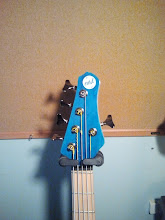
This is the fourth installment in a series of profiles on some of Rock And Roll's most influential bass players.
David Williams "Leo" Lyons was born in Mansfield, Nottinghamshire England November 30, 1943 and began his musical career at the early age of 16.
Throughout 1962 Leo with his band The Jaybirds with guitarist Alvin Lee regularly performed at the Star Club in Hamburg, Germany. Along with playing with The Jaybirds, Leo was also hired to play in the club's house band with Tony Sheridan. From 1963 through 1966 Leo toured with a number bands, worked as a session musician and still found time perform with and manage The Jaybirds.
1967 was a pivotal year for Leo and the band The Jaybirds. Most notably was the name change to Ten Years After and the release of their first album on Deram Records in October. TYA were to soon build a hugh following in Europe.
During 1968 Leo and Ten Years After toured extensively in the United States playing such venues as the Fillmore West in San Fransisco and the Fillmore East in New York City. TYA was one of the first Rock bands to play the legendary Newport Jazz Festival in Newport, Rhode Island.
In August 1969 Ten Years After played the now historic Woodstock Music and Arts Festival. The highlight of their set was the encore of "I'm Going Home" which was captured on film and included in the release of the Academy Award winning Woodstock film documentary. This 10 minute appearance in the film firmly established Ten Years After a place in Rock history.
From the late 60's through the mid 70's Lyons and Ten Years After continued to tour almost constantly playing festivals and venues such as the Isle Of Wright Festival, the Toronto Peace Festival, the Miami Pop Festival, the LA Forum, Madison Square Gardens and the Budokan in Tokyo Japan. It has been estimated by Lyons that TYA were performing to 75,000 concert viewers a week.
In addition to the touring, Ten Years After recorded and released ten multi-million selling albums between 1967 and 1974. In 1975 guitarist Alvin Lee quit the group to concentrate on a solo career and TYA faded out of the music scene. There has been three short lived attempts throughout the 80' and 90's to reform Ten Years After with the original lineup but each time, Lee quit to return to his solo career.
In 1975, he was hired as a studio manager by Chrysalis Records to re-equip and run Wessex Studios in London, England. Leo was also producer for the band UFO from 1974 to 1976, working on the albums Phenomenon, Force It and No Heavy Petting. He has also produced albums for Frankie Miller, Procol Harum and Motorhead to name just a few.
In the late 90's He moved from his farm in Cotswold, England to Nashville, Tennessee to work as staff writer for Hayes Street Music. Leo continues to be active as a songwriter, musician and record producer/engineer. He has been guest bassist on CDs by Savoy Brown and Leslie West and toured extensively in the United States with former Buddy Guy guitarist Scott Holt. Leo currently plays in a reformed Ten Years After with new frontman Joe Gooch.
Leo has used a number of basses during his career. Some of his earlier basses include a 1960 Fender Precision, 1962 Fender Jazz, 1955 Fender Precision, 1970 Acoustic Amp Company Acoustic Fretless bass and the occasional Rickenbacker. He currently uses Lakland and Warwick guitars.
Leo's interests outside music include the paranormal, alternative medicine, martial arts and technology. He is a vegetarian, married with two grown up sons.




















